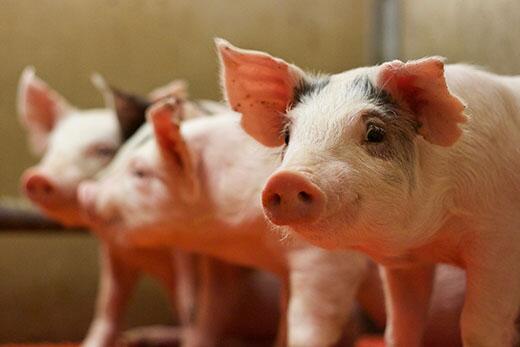Pig probiotics prove positively promising

URBANA, Ill. – Recent regulatory restrictions around antibiotic use in livestock challenge the feed industry, but research from the University of Illinois shows a probiotic product – Clostridium butyricum – can achieve the same growth-promoting results as antibiotics.
“Not being able to use antibiotics, these probiotics or direct-fed-microbials (DFMs) are being used more and more. We have worked with DFMs for the last 10 years and have consistently observed increased growth performance in pigs,” says Hans H. Stein, professor in the Department of Animal Sciences at U of I and co-author of the study.
Stein and his co-authors fed five diets to pigs: a control diet with no antibiotics and no Clostridium butyricum; a control diet with standard antibiotics added; and experimental diets with 1,250, 2,500, or 3,500 cfu per kilogram of Clostridium butyricum added.
“Pigs had better growth performance when we added Clostridium butyricum to the diets compared with the control diet with no antibiotic. And growth performance was the same for the experimental diets as the antibiotic control diet. These results indicate Clostridium butyricum may be used to partly or fully restore the growth performance lost when antibiotic growth promoters are removed from diets for weanling pigs,” Stein says.
Why would feeding this bacterium benefit pig growth? Stein’s team looked at several possibilities, including changes to the pigs’ intestinal morphology.
“There was better morphology in the pigs’ intestinal tracts with the Clostridium butyricum. Villi, the tiny ‘fingers’ lining the intestinal wall, were a little bit taller. The taller the villi, the more nutrients they can absorb. And that can mean better growth performance,” Stein says.
Although Stein didn’t study the effects of villus height on nutrient digestibility in this study, his group has shown the effect in relation to DFMs in previous research.
Stein’s team also evaluated the microbial community in the gut; some DFMs encourage growth of “good bacteria,” leading to secondary benefits. While the researchers found some minor differences, they couldn’t be attributed to the experimental diets.
The team also noted a drop-off in benefits as the inclusion rate of Clostridium butyricum went up, concluding that a dose of 1,250 cfu per kilogram is sufficient to attain increased growth performance in weanling pigs.
“These DFMs, including Clostridium butyricum, seem to have pretty consistent positive effects in diets for young pigs. I think there’s a good reason they’re being used more and more in the industry. It’s a good return on investment if you add them to the diet,” Stein says.
The article, “Inclusion of the direct-fed microbial Clostridium butyricum in diets for weanling pigs increases growth performance and tends to increase villus height and crypt depth, but does not change intestinal microbial abundance” is published in the Journal of Animal Science [DOI: 10.1093/jas/skz372]. Co-authors include Gloria Casas, Laia Blavi, Tzu-Wen Cross, Anne Lee, Kelly Swanson, and Hans Stein. The work was supported by BASF.
The Department of Animal Sciences is part of the College of Agricultural, Consumer and Environmental Sciences at the University of Illinois.